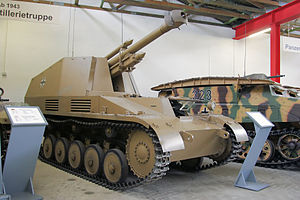Self-propelled howitzer wasp
| Self-propelled howitzer wasp | |
|---|---|

Self-propelled howitzer Wespe in the Munster tank museum |
|
| General properties | |
| crew | 5 men |
| length | 4.81 m |
| width | 2.28 m |
| height | 2.30 m |
| Dimensions | 11.48 t |
| Armor and armament | |
| Armor | Front: 18 mm, sides / rear 15 mm, structure: 10 mm |
| Main armament | 10.5 cm light field howitzer 18 ML / 28 with 32 rounds of ammunition, service life> 10,000 rounds |
| Secondary armament | 7.92 mm MG 34 with 600 rounds |
| agility | |
| drive | Six-cylinder in-line engine Maybach HL 62 TR 140 PS |
| suspension | Leaf suspension |
| Top speed | Road 40 km / h, terrain 24 km / h |
| Power / weight | 12 hp / t |
| Range | Road 200 km, terrain 140 km |
The Panzerhaubitze Wespe ( Sd. Kfz. 124 ) was a self-propelled gun used by the German Wehrmacht during World War II .
development
The high demand on the eastern front for mobile artillery led to the development of the "Wasp" in 1942. The “Wasp” was designed as a joint project by the Alkett (body), MAN (chassis) and Rheinmetall-Borsig (gun) companies and built by Famo in Warsaw.
The chassis of the Panzer II Ausf. F served as the chassis , modifications included moving the engine forward to the center of the vehicle and a slightly extended hull. The tall, box-shaped structure was open to the rear and top, and the 10.5 cm light field howitzer 18 was mounted there. The driver sat in a closed driver's cell, while the rest of the crew in the superstructure had only limited armor protection. However, since the vehicles operated far behind the front due to the range of the cannon (max. Firing range 10,650 m), a threat from enemy infantry hardly played a role.
From February 1943 to June 1944 a total of 683 wasps were produced by Famo. Since the ammunition supply was very limited with 32 rounds, an additional 158 ammunition carriers were built on the same chassis. Each battery was assigned two ammunition carriers, such a vehicle could load 90 rounds. This resulted in the advantage that if a “wasp” got stuck, the field maintenance troops could remove the howitzer and mount it on an ammunition carrier, so that an operational “wasp” was available again.
The correct designation of the vehicle was "leFH 18/2 on chassis PzKpfw II (Sf)" (Sd.Kfz. 124). On February 27, 1944, the use of the name Wespe was prohibited on instructions from Adolf Hitler as unsuitable for a combat vehicle.
commitment
The Wasp was delivered to the Eastern Front for the summer offensive in 1943 and was used for the first time in the Battle of the Kursk Arc . It was planned to equip each tank division with a division of self-propelled artillery guns. Two of the division's three batteries were equipped with six wasps each, so that the armored divisions had twelve wasps at their disposal. Another six Hummel self-propelled howitzers were available in the third battery, so that one armored division had 18 self-propelled artillery guns. In a few exceptions, Panzergrenadier divisions were also able to use the Wasp .
Since it had low failure rates, it was in service on the Eastern and Western Fronts and in Italy until the end of the war.
See also
- Self-propelled howitzer Hummel
- List of tracked vehicles of the Wehrmacht
- Artillery troops from the Wehrmacht and Waffen-SS
Web links
- Images and data (English)
- Pictures and description (English)
Individual evidence
- ^ S. Hart & R. Hart: German tanks in World War II; Gondolino (1998), ISBN 3811216678



